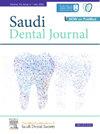Clinical profile of Brazilian patients with temporomandibular joint disorder and orofacial pain: A 20-year retrospective study
IF 1.7
Q3 DENTISTRY, ORAL SURGERY & MEDICINE
引用次数: 0
Abstract
Objective
Temporomandibular joint disorder (TMD) comprises several musculoskeletal conditions in the orofacial region, with chronic pain and/or dysfunction involving the temporomandibular joint (TMJ) and masticatory muscles. This study assessed the clinical characteristics of patients with TMD treated at a public tertiary care facility in Brazil.
Methods
In this retrospective study, we assessed data from adult patients attending the Center for Occlusion, TMD, and Orofacial Pain at a Brazilian school of dentistry, from 2000 to 2020. Data from eligible charts were collected: demographic variables, clinical complaints, location of pain, pain intensity (10-point VAS), duration of treatment, and therapeutic procedures. Data were analyzed using descriptive and inferential statistics at the 0.05 significance level.
Results
The sample consisted of 2324 patients (79.4 % females) with a median age of 38 years and median duration of treatment of 35 days. Major clinical complaints were craniofacial pain (including in the TMJ region) (82.9 %), self-reported bruxism (clenching/grinding) (44.6 %), and clicking/crepitation (39.1 %). Craniofacial pain was associated with female gender and age of 39 years and older, but not with bruxism. The most frequent procedures were counseling (96.5 %), exercises (47.5 %), occlusal splints (18.5 %), and physiotherapy (13.8 %). Reduction in pain intensity was moderately associated with multiple (3 or more) therapies and longer duration of treatment.
Conclusion
It can be concluded that the patients presented a diversity of clinical characteristics requiring individualized treatment. A multimodal, interdisciplinary therapeutic approach, including counseling, appears to benefit most patients with TMD-related pain.
巴西颞下颌关节紊乱和口面部疼痛患者的临床概况:20 年回顾性研究
目的颞下颌关节紊乱症(TMD)包括口面部的几种肌肉骨骼疾病,涉及颞下颌关节(TMJ)和咀嚼肌的慢性疼痛和/或功能障碍。这项研究评估了在巴西一家公立三级医疗机构接受治疗的 TMD 患者的临床特征。在这项回顾性研究中,我们评估了 2000 年至 2020 年期间在巴西一所牙医学院咬合、TMD 和口面疼痛中心就诊的成年患者的数据。我们从符合条件的病历中收集了以下数据:人口统计学变量、临床主诉、疼痛部位、疼痛强度(10 点 VAS)、治疗持续时间和治疗过程。结果样本包括 2324 名患者(79.4% 为女性),中位年龄为 38 岁,中位治疗时间为 35 天。主要临床主诉为颅面疼痛(包括颞下颌关节区域)(82.9%)、自我报告的磨牙症(咬牙/磨牙)(44.6%)和咔嗒声/咀嚼声(39.1%)。颅面疼痛与女性性别和 39 岁及以上年龄有关,但与磨牙症无关。最常见的治疗方法是咨询(96.5%)、锻炼(47.5%)、咬合夹板(18.5%)和物理治疗(13.8%)。疼痛强度的减轻与多种(3 种或更多种)疗法和较长的治疗时间有一定关系。包括心理咨询在内的多模式、跨学科治疗方法似乎能使大多数 TMD 相关疼痛患者受益。
本文章由计算机程序翻译,如有差异,请以英文原文为准。
求助全文
约1分钟内获得全文
求助全文
来源期刊

Saudi Dental Journal
DENTISTRY, ORAL SURGERY & MEDICINE-
CiteScore
3.60
自引率
0.00%
发文量
86
审稿时长
22 weeks
期刊介绍:
Saudi Dental Journal is an English language, peer-reviewed scholarly publication in the area of dentistry. Saudi Dental Journal publishes original research and reviews on, but not limited to: • dental disease • clinical trials • dental equipment • new and experimental techniques • epidemiology and oral health • restorative dentistry • periodontology • endodontology • prosthodontics • paediatric dentistry • orthodontics and dental education Saudi Dental Journal is the official publication of the Saudi Dental Society and is published by King Saud University in collaboration with Elsevier and is edited by an international group of eminent researchers.
 求助内容:
求助内容: 应助结果提醒方式:
应助结果提醒方式:


